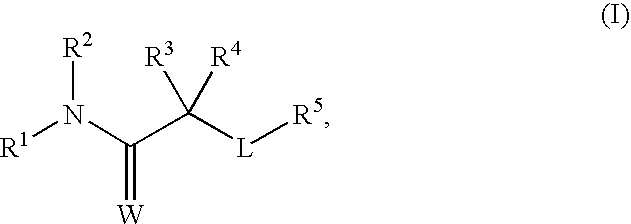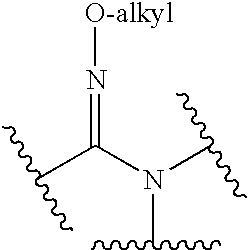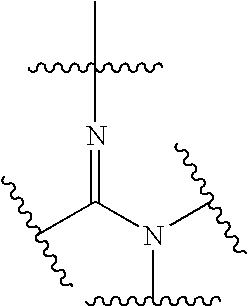Amide and amidine derivatives and uses thereof
a technology of amidine and amide, which is applied in the field of amide and amidine derivatives, can solve the problems of increased anxiety and aggression, neuronal loss and neuronal dysfunction, and impaired cognitive function,
- Summary
- Abstract
- Description
- Claims
- Application Information
AI Technical Summary
Benefits of technology
Problems solved by technology
Method used
Image
Examples
example 1
(1E)-2-(2-Chloro-4-fluorophenoxy)-Y-cyano-N-[(E)-5-hydroxy-2-adamantyl]-2-methylpropanimidamide
example 1a
(1E)-2-(2-Chloro-4-fluorophenoxy)-N-[(E)-5-hydroxy-2-adamantyl]-2-methylpropanamide
[0536]The titled compound was synthesized according to the methods described by Sorensen et al., Bioorg. Med. Chem. Lett. 2007, 17, 527-532.
example 1b
(1E)-2-(2-Chloro-4-fluorophenoxy)-N-[(E)-5-hydroxy-2-adamantyl]-2-methylpropanethioamide
[0537]To a solution of Example 1A (0.76 g, 2 mmol) in toluene (25 mL) was added Lawesson's reagent (0.81 g, 2 mmol) and then the reaction mixture was heated at 80° C. for 4 hours. The reaction mixture was concentrated under reduced pressure, and the residue was partitioned between saturated aqueous NaHCO3 and ethyl acetate. The organic layers were combined, dried (MgSO4), filtered and concentrated. The residue was purified by flash chromatography (SiO2, 0-40% ethyl acetate in hexanes) to provide the titled compound. MS (DCI+) m / z 398 (M+H)+.
PUM
| Property | Measurement | Unit |
|---|---|---|
| temperature | aaaaa | aaaaa |
| volume | aaaaa | aaaaa |
| volume | aaaaa | aaaaa |
Abstract
Description
Claims
Application Information
 Login to View More
Login to View More - R&D
- Intellectual Property
- Life Sciences
- Materials
- Tech Scout
- Unparalleled Data Quality
- Higher Quality Content
- 60% Fewer Hallucinations
Browse by: Latest US Patents, China's latest patents, Technical Efficacy Thesaurus, Application Domain, Technology Topic, Popular Technical Reports.
© 2025 PatSnap. All rights reserved.Legal|Privacy policy|Modern Slavery Act Transparency Statement|Sitemap|About US| Contact US: help@patsnap.com



